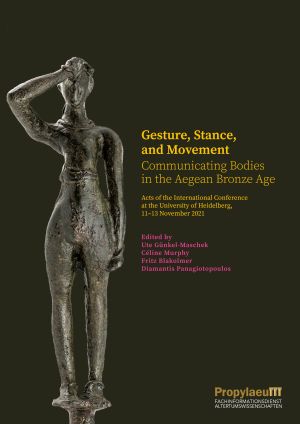Gesten, Haltung und Mimik sind zentral für die Vermittlung von Bedeutung durch Handlung und körperliche Kommunikation. In Bildwerken stellen sie aktive oder kommunikative Aspekte der Figuren dar und setzen sie in kohärenten Erzählungen zueinander in Beziehung. Gerade in der Erforschung von Gesellschaften mit einem begrenzten Korpus entzifferter Texte, wie jenen der Ägäis vom Neolithikum bis zur Spätbronzezeit, ist dies für das Verständnis antiker Sinnzusammenhänge besonders wichtig. Der aus einer Heidelberger Tagung von 2021 hervorgegangene Band befasst sich in 29 Beiträgen mit alten Hypothesen und neuen Interpretationsansätzen zur ‚Körpersprache‘ im minoischen Kreta und im mykenischen Griechenland.
2021, Heidelberg: Propylaeum, 2024. https://doi.org/10.11588/propylaeum.1309
Identifier
ISBN 978-3-96929-270-9 (PDF)ISBN 978-3-96929-271-6 (Hardcover)Veröffentlicht
21.11.2024
InhaltsverzeichnisSeitenI. Frameworks of Analysis for Communicating BodiesII. Communication Through Expression and MovementFemale Initiation or Non-Narrative Absorption?119-127Bodily Movement as Multisensorial Experience in Minoan Cavernous Spaces129-139III. Gesture, Posture, and Societal MattersIV. Of Deities and Humans243-257V. Communication in Ritual ActionReassessing Aegean Bronze Age Depictions of Human and Animal Figures Interacting with a Tree or a Column291-305VI. Gesture, Posture, Sex, and GenderThe Neolithic Antecedents of Bodily Comportment in the Aegean313-333Applying Sociobiology and Evolutionary Psychology to the Iconography of the Human Body in Bronze Age Crete351-370VII. Stances of Triumph, Defeat, and CombatBody Poses of Victorious and Defeated Warriors in Late Bronze Age Aegean Iconography and Their Egyptian Comparanda373-378Emulating the Postures of Near Eastern Rulers and Deities in Aegean Bronze Age Iconography389-404VIII. Death and the Communicative BodyExploring Mortuary Gestures and Their Meaning at the Petras Cemetery, Siteia, Crete417-423Re-considering the Potential Identities of Figures on the LM III A2 Agia Triada Sarcophagus425-430


No comments:
Post a Comment